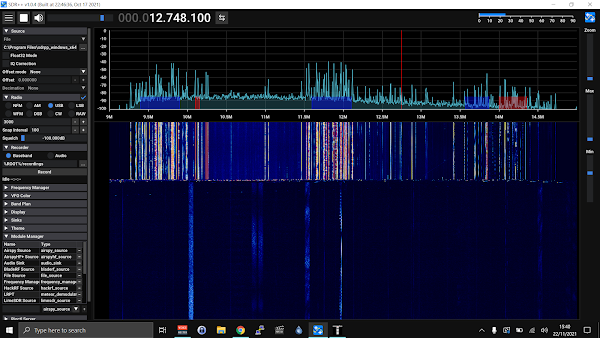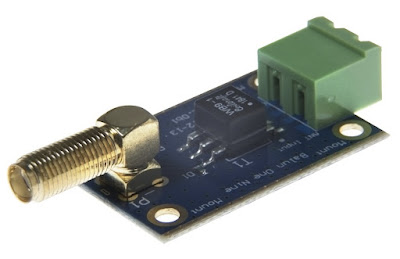A few days ago I embarked on a little project born out of necessity. I wanted to get into proper HF (High Frequency or "Shortwave") Listening for a while, monitoring radio frequencies between 3-30 MHz. The kind of radio waves that exploit the atmosphere to propagate across thousands of miles. Unfortunately my operating location is a little compromised, a rented flat with no way to get cables outside (not least in November) and a high-density residential area with all sorts of RF noise. In short: I needed to get outside.
I have been using my SDR outside as I’ve documented on the blog recently for capturing weather satellite transmissions. I had wondered whether I could go out and use the same kit for SWL. I had a fiberglass pole, and I had a little SMA-BNC-wire terminals adapter thing so I could attach long lengths of wire to my SDR. Shortwave monitoring requires antennas designed for long wavelengths, tens of metres or more, and so the antennas tend to be quite large.Luckily that’s only for making an efficient antenna. Broadcast shortwave signals tend to be high-powered and so in reality any sufficiently long length of wire will pull in signals. The wire will - of course - work better at one particular set of frequencies and its harmonics. It should also pull in lower-powered signals well as the SDR is very sensitive and away from interference and other electronic devices.
I opted to eliminate the feedline coax from the antenna to minimise loss, attaching it instead directly to the SDR. I could have run the coax of the wire to the top of the pole and started my antenna there, but would also then have to run a long wire back to ground down the pole, which is extra work. The whole setup took around 10 minutes including checking things with my NanoVNA.This meant that the antenna configuration was a sloping end-fed wire with a counterpoise that seemed to do something, but wasn’t perfect. I hit record and waited for 43 minutes (until I decided it was too cold to continue standing outside). Pack up took 5 minutes with this setup.
I opted to use SDR++ as I do for all of my SDR work, and the recording was done in its native 16-bit mode. By restricting the bandwidth of my SDRPlay RSP1A to 6 MHz this meant I could use the full 14-bit dynamic range of the device. The recording came out at 58 GB - yikes. Clearly if you’re going to this a lot you need some storage system for it and a good system for organising. But it was a complete success and the waterfall from the first scan looked amazing:
So many lines! Let’s hope some aren’t images or internal oscillations… I also recorded 20 mins worth of 4.8-10.8 MHz that revealed just as many stations. The time of day wasn’t perfect for propagation there, though, so performance was definitely lower.
Five days later I repeated this experiment again, only I went out for an evening trip and also a much lower frequency coverage. I made ten minute recordings of both 0-6 MHz and 7-13 MHz. I also made a 30 second recording of 0-2 MHz with a narrower bandwidth and slightly better signals in to the SDR, making a few stations stronger (or the propagation changed - not sure) and revealing others. A large amount of signals in the MW broadcast band were booming in from Spain, and we’ll investigate this (and other goodies) in later posts.
So, what to do with this data? Well, apart from the technical aspect the project was to see how much information there is in 6 MHz chunks of spectrum. How much image data, text data, voice data and whatnot. How many stations are there, where are they, what are they all doing, and how much can we access. It’s as much an art project than anything else - a block of time frozen and recorded, with content fed in from all over the world.
Going forward I need to think about a better antenna configuration for this to improve the results. I’m essentially using an end-fed antenna without the required unun, so there’s an impedance mismatch. I’ve ordered a Nooelec 9:1 balun and will cut a trace on the PCB to use it in UnUn mode, since it’ll be an unbalanced antenna. Unfortunately I won’t have the space to make a fully-balanced dipole, which would need the PCB in balun mode.This is also all good practice for when I eventually get transmitting on HF, so I’ll have an idea of what antennas work best and how to go about matching impedances - I’ve never cared for this kind of thing before but it’s important for reducing noise on receiving and hugely important for efficiency and not damaging your rig when transmitting.
I did find the performance on MW outstanding at night, but for serious monitoring I’ll need something a bit more directional, so I’ll be looking into a tuned wire loop for this - lots of loops of wire with a variable capacitor across the ends before it meets the coax feedline to tune it to resonate at a wanted frequency. A bit like those ones you used to get with hifi systems but better. I’ll also be able to rotate the loop to point at the signals I want, or away from unwanted signals to reduce them.
In short I’ve had an absolute blast this week, and I definitely recommend trying something like this in an open area. If you usually operate HF radio portable (perhaps on SOTA/POTA) then why not bring a laptop and an SDR and record some spectrum for when you get home? It isn’t that much extra kit to bring, and you’ll double your fun.
I’ll be blogging my finds over the next few weeks, but I’ve put the two spreadsheets that I'm working on here for you all to look at. You’ll see that I’m decoding data and adding links to it all, and IDing stations if possible where I go.
22nd Nov 2021 - https://docs.google.com/spreadsheets/d/1-Kn1HYU7JaWKGnFhF_Bo9p1GUHMkEPtERuxZL4-GfIg/
29th Nov 2021 - https://docs.google.com/spreadsheets/d/1bMeuhqPOgLfnyG-xEbaMLMlB6S0Nqf9f_9J56PII-aY/
 Skip to main content
Skip to main content






Comments
Post a Comment